Stalking bears with volunteer Bill Baker in Canada’s Riding Mountain National Park.
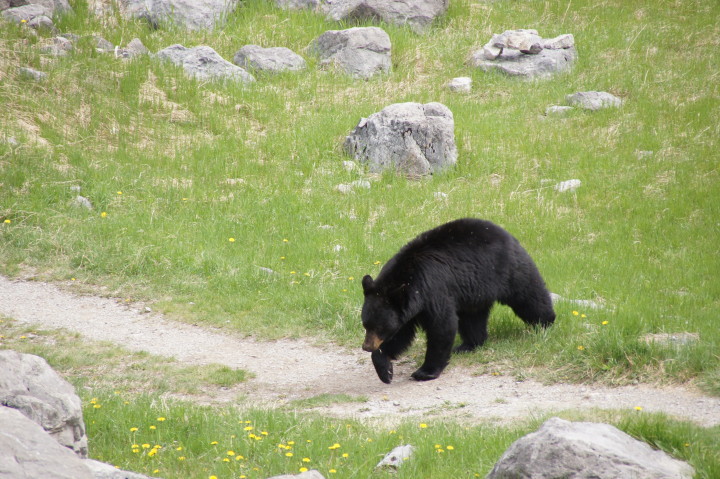
Black bears are a frequent sight in the Canadian wilderness, but it’s best to keep a distance
«Look, a bear,» says Bill and hits the brake. «Can’t be,» I say, «only black bears have been seen here and this thing was of a very light brown.» «That was a bear,» Bill insists. He says black bears can be black, but also any shade up to tan. He should know, he’s come to the Riding Mountain National Park for over 50 years now, regularly.
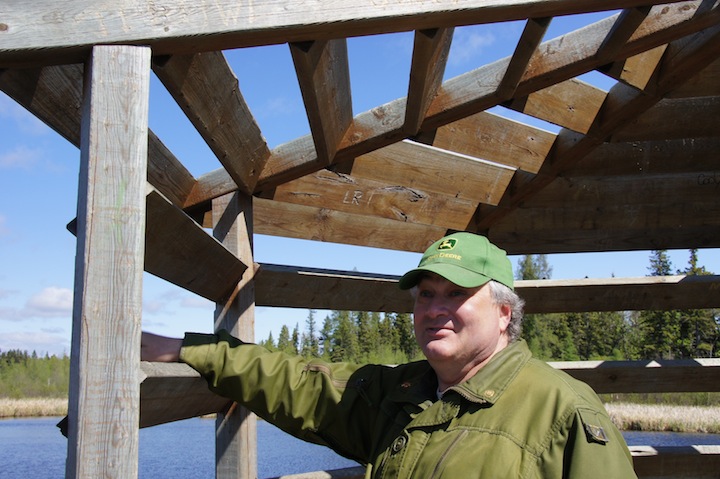
Bill Baker at his favorite spot at the Ominnik Marsh
We are cruising on Highway 19, which leads from the eastern park gate to Wasagaming, a little town in the park’s south. Nobody is allowed to live there, not permanently anyway, but in summer it becomes a hot spot for chalet owners, campers and day-trippers. Bill used to spend summer holidays here with his parents, here he got his first holiday job at the grocery store, his first traineeship as a student, and his first job after uni, at the office of the park ranger.
When he was 10, Bill seemed glued to the park interpreter of Riding Mountain. The man who made it his job to get the visitors acquainted with the geological, biological, and cultural qualities of this national park in Manitoba province, turned the boy into a lifelong park fan and directly influenced his career choice: «At the end of that summer I knew I was going to become something like a park interpreter.»
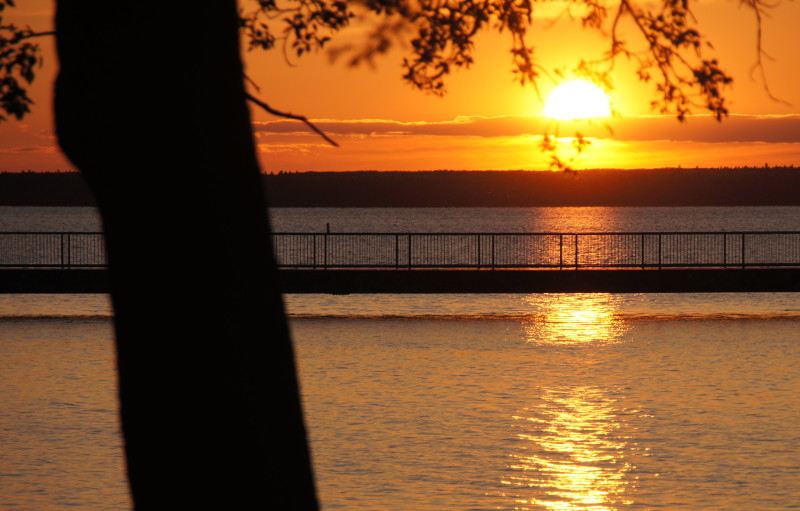
Sunset at Wasagaming in Riding Mountain National Park
Bill studied geography, worked at the ranger’s office at Riding Mountain for fours years, and finally ended up at the forestry administration of Manitoba province, teaching schoolchildren how to handle campfires correctly. When he got a chance to take early retirement he knew he wanted to return to the area of Riding Mountain.
He has since been a member of the Friends of Riding Mountain and one of the many volunteers who make sure that the Trail Guides are up to date, the Nature Shop at the Visitor Center is open throughout summer, the kids can attend camps and workshops to learn more about the park, and that the grown-ups can participate in a triathlon in summer or a loppet in winter. Almost every park in Canada is supported by such Friends.

Elks don’t give a damn about humans
Meanwhile Bill has spotted another bear, a black one this time, and even I recognized it as a bear before it turned its back on me and disappeared into the bushes. The unnerving thing about bears close enough to see is that they quickly run off before you get a chance to grab your camera. It’s the same with deer, foxes, wolves. Only elks seem in no hurry and stoically continue to graze. And the bison is much too heavy to take flight just because of a car.
Non-domestic bovines find fewer and fewer grazing areas in Canada. But here at Riding Mountain National Park, the prairie is one of three distinct eco-systems, along with the northern spruce forest and the deciduous forest. The park is home to few dozen bovines who graze within an extensive, drive-through enclosure. Now, in late May, the bison are still on their winter pasture and out of sight. A lone animal has found its way through an open gate onto the road and is feasting on the grassy tufts alongside it.

Bison auf dem Weg zu Audy Lake
Occasionally a bison may disappear into the wilderness. That’s why a poster at the start of the Strathclair Trails, near the winter pasture, is alerting us to the danger of free-roaming bison. The trail is one of 39 hiking options presented in the Guide, which the Friends of Riding Mountain prepare and publish in collaboration with the park administration.
Some trails are fairly easy and leisurely, such as the wooden walkway across the Ominnik Marsh, one of Bill’s favorite spots in the park. «The colors in summer and the birdsong are just extraordinary,» he says. Other trails amount to hikes of several hours, and some will take you deep into the backcountry and can’t be done in one day. There are 16 campsites out there that you can use if you have registered with the park rangers beforehand. If you don’t report back, a search troop will go looking for you. That’s because in the sticks you can easily make a few scary acquaintances, say with a bear or a wolf.
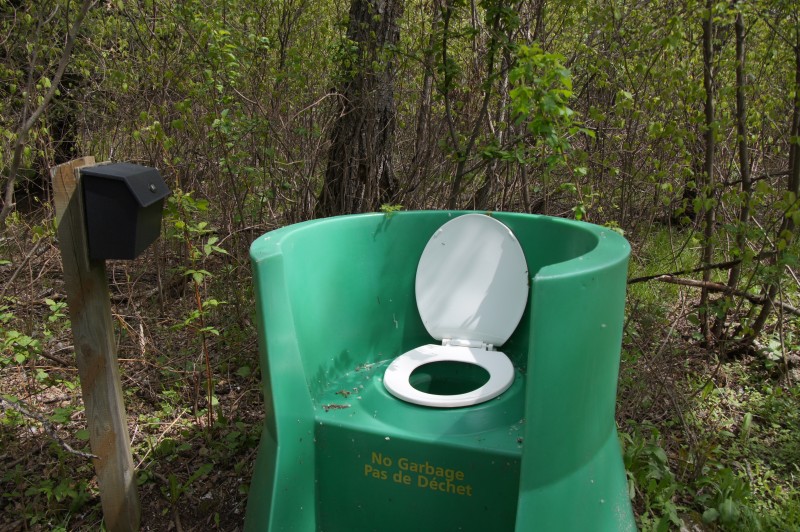
I’d rather not see a bear now: open-air toilet at the national park
And bears, of course, are omnivores. They will readily descend on your provisions. That’s not just bad for you, who are now left without food, it’s also bad for the interaction of the two species, humans and bears. Bears on the prowl who find they can feast on food «provided» by humans lose their fear and become problem bears. In Jasper, a town in the Rocky Mountains that is surrounded by a national park with lots of black and grizzly bears, has therefore invented the bear-proof garbage bin. It is now used in all areas where humans move through bear territory.
Now, to be walking about in bear country is of course immensely inspiring. It sets your fantasy on fire. They tell you to make noises and to bring along a pepper spray just in case. Not to look for berries or mushrooms, because that’s what the bear is doing. Anyone traveling alone, as I am, will soon have great expectations mixed with great anxiety. Or is it a frisson, known as a feeling of great excitement and fear? I want to see bears and yet I’m totally relieved that none is lurking behind a tree.
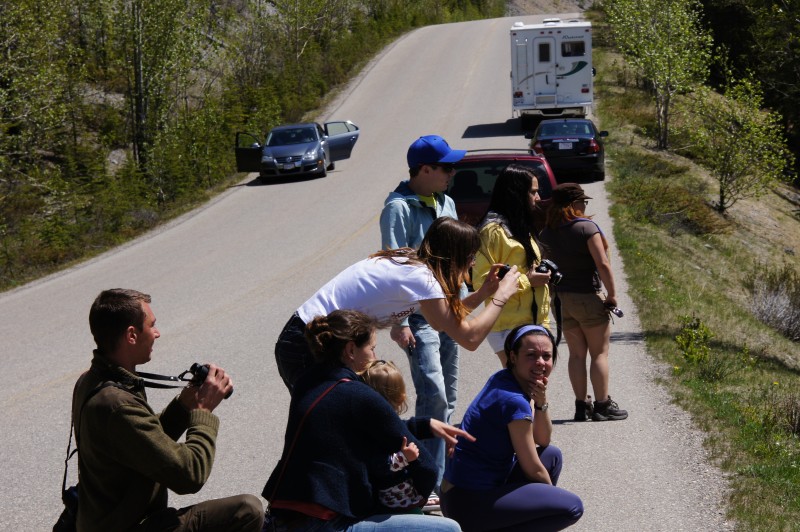
Photo trap: tourist crowd takes aim at a bear in Jasper National Park.
Most bear country tourists will know what I’m talking about. The bears are one of the main reasons for a trip to the park, and they are also a target for a great many cameras. If a car is parked roadside at Jasper National Park, for example, soon more and more people will stop there too because it means that there’s something to be photographed, mostly a bear. The specimen on the shore of Lake Medicine in Jasper seems to ignore the rapidly growing crowd. After a lazy glance at us it goes on munching daisies.

This bear in Jasper has a strong liking for daisies
What was it that Bill said? Bears have an excellent sense of smell and good hearing, but luckily their vision is extremely bad.
Translated from German by Rosemarie Graffagnini
